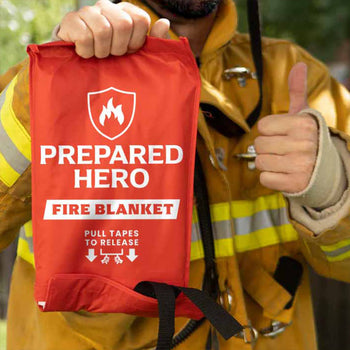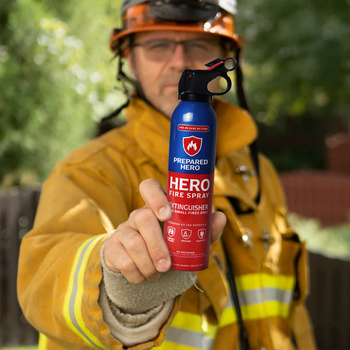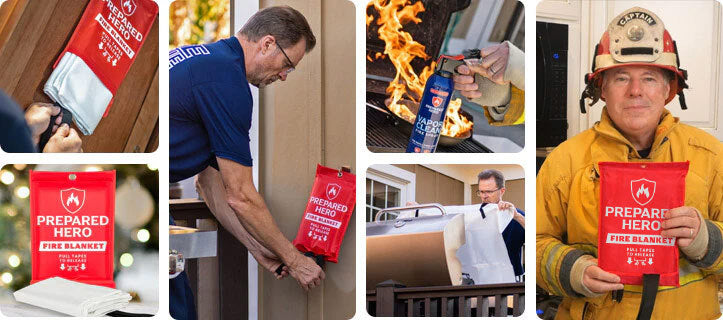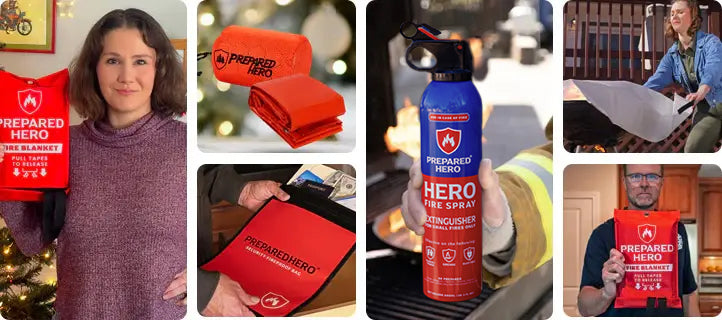Where you put your smoke detectors matters just as much as installing them. Proper placement makes sure they can detect...
Recreational boating is a popular activity in the US. However, a fire is one of the worst things that can happen while you're on the water. In fact, hundreds of people die from boat fires each year in the US alone. Unfortunately, you can't be 100% safe from it.
So what should you do if a fire breaks out in the front of your boat? Let's find out.
What to Do if a Fire Breaks Out in the Front of Your Boat
- Stop the boat immediately.
- Turn off the engine and fuel supply.
- Turn the back of the boat into the wind.
- Use a fire extinguisher to put out the fire.
- Call for help using a marine radio.
- Evacuate the boat if needed.
What Should You Do if a Fire Breaks Out in the Front of Your Boat?
Here's what you should do if a fire breaks out in the front of your boat:
1. Stop the boat immediately.

If you're underway and a fire breaks out in front of your boat, stop the boat immediately. Look at your surroundings and avoid other vessels as much as possible.
Then, ask everyone to put on their PFDs (personal flotation devices) in case you need to evacuate the boat.
As the fire gets bigger, you might get disoriented. Keep calm and focus on your next step: turning off the engine and fuel supply.
2. Turn off the engine and fuel supply.

Most recreational boats have kill switches connected to the engine. If yours doesn't have one, turn off the engine right after stopping the boat.
Remember, leaving the engine running can cause more problems. For one, it can overheat and make the fire worse.
Next, turn off the fuel supply because it might ignite as it flows to the motor, then explode. Once you turn off the supply, fuel won't leak out if your lines get damaged.
3. Turn the back of the boat into the wind.

Your boat's position relative to the wind can make or break the fire in front of your boat.
Turn the stern (back of the boat) into the wind. Doing so will keep the fire from spreading to other parts of your boat.
You can also use the same wind principle if a fire breaks out on the side or back of your boat. Although the wind can't put out the fire on its own, having it blow against the direction of the fire will keep the passengers safe.
Aside from preventing the fire from spreading, turning the fire against the wind will also reduce smoke inhalation. The less smoke the wind blows in the passengers' direction, the fewer the chances of inhalation.
4. Use a fire extinguisher to put out the fire.

Various fire extinguisher types put out different types of fire. Here's a quick peek at the classes of fire:
Class A: caused by solid materials like paper, textile, and wood
Class B: caused by flammable liquids and gases like petroleum and propane
Class C: caused by electrical equipment
Class D: caused by metals like aluminum and magnesium
Class K or F: caused by oil and grease
Since most boat fires are Class B fires, you must use a fire extinguisher that can put them out. These include water mist, powder, foam, and carbon dioxide extinguishers.
However, out of all of them, powder extinguishers can put out the most fires. In particular, they can extinguish Class A, B, C, and D fires.
Pro tip: never use water to put out a Class B fire, as it can spread flammable liquids.
Additionally, remember the acronym PASS (Pass, Aim, Squeeze, Sweep) when using a fire extinguisher.
The PASS Method
Pull
First, pull the pin from the fire extinguisher. The tamper seal will break once you remove the pin.
Aim
Then, aim the nozzle at the base of the fire. Don't aim it at the flames.
Squeeze
Slowly squeeze the handle until the fire extinguisher releases its content.
Sweep
Lastly, sweep the nozzle from side to side at the base of the fire. Do this until you put out the fire. If the fire reignites, repeat steps two to four.
Hero Fire Spray: An Alternative to Fire Extinguishers

While fire extinguishers help, they can be expensive, heavy, and hard to store. The residue from the fire extinguisher may also be hard to clean up.
Use a fire spray if you want a more affordable, lightweight, and convenient way to put out a fire in seconds.
The Hero Fire Spray is an easy-to-use alternative to fire extinguishers. It will help you deal with minor fire accidents and stop them before they turn into bigger disasters.
Plus, Prepared Hero's fire spray is biodegradable and non-toxic. Unlike a fire extinguisher, you can safely use it around your family and pets. They're also eco-friendly, so you're taking part in saving the environment.
Here's a table showing the differences between the Hero Fire Spray and a regular fire extinguisher:
| Hero Fire Spray | Regular Fire Extinguisher |
| Lightweight, easy to carry | Heavy, hard to carry |
| Easy to store | Needs more space for storage |
| 100% biodegradable | Mostly made of non-biodegradable materials |
| Non-toxic | Toxic |
| Easy to clean | Hard to clean |
| Safe for kids and pets | Not safe for kids and pets |
5. Call for help using a marine radio.

In some cases, you won't be able to put out the fire by yourself. Even if you do, you still have to call for help using a marine VHF (very high frequency) radio.
A distress call will alert nearby vessels and contact emergency responders such as the Coast Guard. When you call emergency responders, give them the following details:
- Current location
- Type of boat
- Size of boat
- Boat's name
- Number of passengers
Additionally, use signaling devices like flares, horns, and whistles if you have them.
6. Evacuate the boat if needed.

If the responders arrive and ask you to evacuate, do it immediately.
First, gather the passengers in one location and ask them to be calm. Then, instruct them to wear their life jackets. After this, deploy the life raft and evacuate people orderly.
How to Prevent a Fire From Breaking Out in the Front of Your Boat
- Brief passengers about safety protocols.
- Have a fire extinguisher on board.
- Create a fire safety kit.
- Stock up on life jackets.
- Have a complete first aid kit.
Most fires can be prevented with the right tools and knowledge. Here's how to prevent a fire from breaking out in front of your boat:
1. Brief passengers about safety protocols.

First and foremost, brief your passenger about safety protocols. Show them how to properly wear life jackets and explain the evacuation plan before starting the trip.
Answer all of their questions and ensure everyone understands what you just explained.
2. Have a fire extinguisher on board.

Prevent small fires from turning into huge disasters by having a fire extinguisher or fire spray on board. Fire extinguishers put out fires in a matter of seconds, so always check that yours are in good working condition.
In addition, put your fire extinguisher or fire spray in an accessible place, so you can get it when needed.
3. Create a fire safety kit.

Make a kit containing fire safety items that help you stay safe as you put out or escape a fire. Your kit must include the following:
- Fire spray
- Flashlight
- Fire protection gloves
- Escape rope
- Fire blanket
- Glow stick
- Smoke mask
4. Stock up on life jackets.

Make sure you have enough life jackets for all passengers. This ensures that everyone stays safe should you need to evacuate the boat.
5. Have a complete first aid kit.

You must have a first aid kit on board to tend to cuts, wounds, and injuries until they can be treated by a professional. Make sure that all items in your kit are clean and working properly.
Generally, a first aid kit should contain bandages, gauze pads, sanitizer, pain relievers, tweezers, ointment, and cold compress. You can add more items depending on what passengers might need.
Frequently Asked Questions
What should you do if a fire breaks out?
You should get out, stay out, and call 911 if a fire breaks out. Then, shout "Fire!" many times, so people around you get warned. Use the stairs if you live in a building with elevators.
How do you put out a fire in a boat?
Here's how to put out a fire in a boat:
- Stop the boat immediately.
- Turn off the engine and fuel supply.
- Turn your boat so the wind blows the fire away from it.
- Use a fire extinguisher to put out the fire.
- Call for help using a marine radio.
- Evacuate the boat if needed.
What is the first step when responding to a boat fire emergency?
The first step when responding to a boat fire emergency is stopping the boat immediately. You should cut off the engine and the fuel supply to prevent the fire from getting worse. Then, turn your boat so the wind blows the fire away from it. After this, grab a fire extinguisher to put out the fire.
What is the best way to fight a fire on a boat with a hand held fire extinguisher?
The best way to fight a fire on a boat with a hand-held fire extinguisher is to hold the fire extinguisher upright. Then, aim the nozzle at the fire's base, not the flames. Slowly squeeze the handle until the fire extinguisher releases its content, and sweep the nozzle from side to side at the base of the fire.
Where is the best place to put a fire extinguisher on a boat?
The best place to put a fire extinguisher on a boat is in an accessible location where people can reach it easily. These locations include the steering station, galley, and engine room.
Conclusion

There have been fatalities on boats not too far from shore merely because people ignored fire safety protocols. So, print or bookmark this guide to ensure you know what to do if a fire breaks out in the front of your boat.
Remember, prevention is always better than cure. So, what are you waiting for? Complete that boat fire safety kit by getting your fire safety items now!


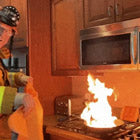 Fire
Fire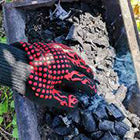 Safety
Safety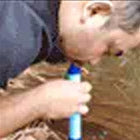 Survival
Survival Protection
Protection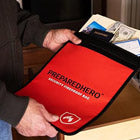 New
New
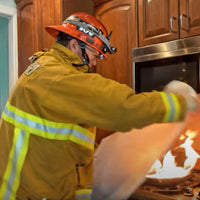 Fire
Fire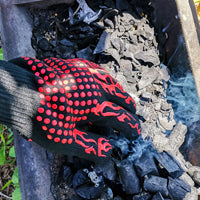 Safety
Safety Survival
Survival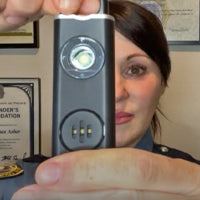 Protection
Protection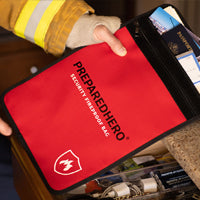 New
New
